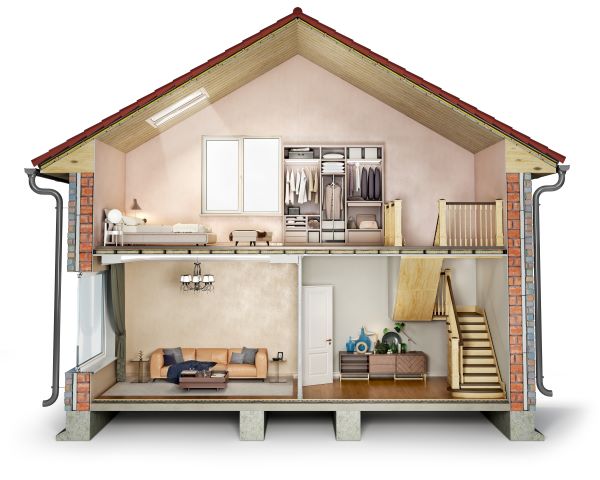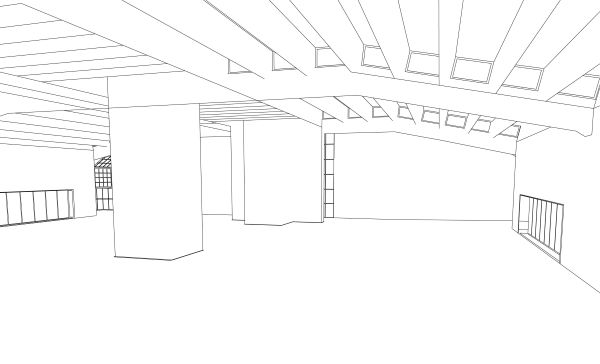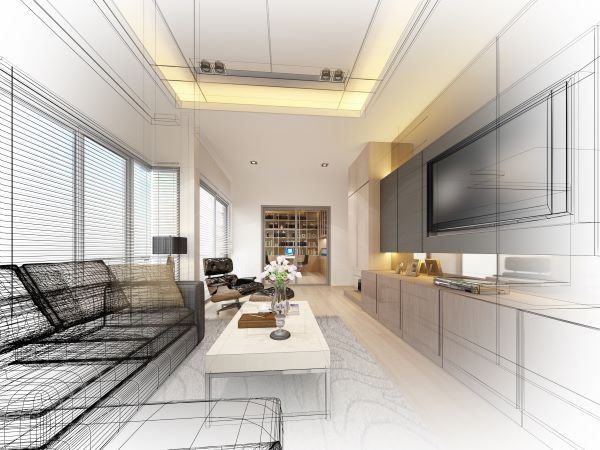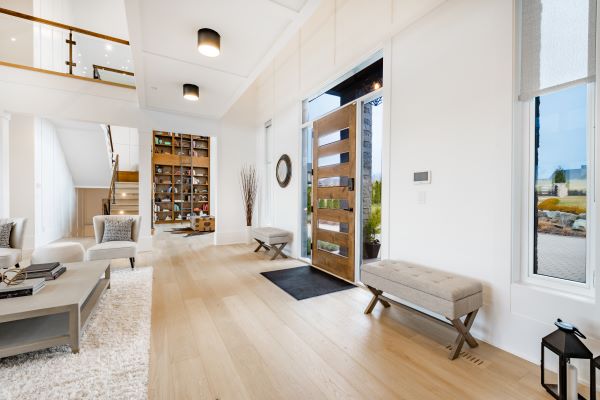If you’re interested in planning interior environments like homes and office space, you might have an interest in job roles in interior architecture and interior design. Both interior designers and interior architects work to create the indoor spaces where people spend their time. The aspects of planning and design on which interior architects and interior designers focus differ – and so may the education they pursue in preparation for their respective careers.

The Difference Between Interior Design and Interior Architecture
At first, interior design and interior architecture may sound so closely related that they would be interchangeable. Although both of these fields revolve around the design and planning of interior spaces – and the professionals who hold them often collaborate – they are distinct jobs. Interior designers and interior architects have unique areas of focus and separate approaches to the development of interior environments.
Architecture refers to the planning of buildings. An interior architect is an architect who applies their skills to the building and space planning of interiors, or inside spaces, as opposed to exterior (outside) elements of a building project. Interior designers also focus on inside spaces.
There is considerable overlap between what interior designer responsibilities and interior architect responsibilities might entail in a given project. In general, though, the distinction between these two careers comes down to areas of focus and knowledge needed for each job role.
According to the New School of Architecture & Design, interior architects are more involved in the functional space planning than in the aesthetic finishes used in the space than interior designers. They prioritize the structural elements of planning interior spaces. Further, interior architects tend to emphasize the technical aspects of building design more than interior designers do, the job search website Indeed reported.

In other words, using a combination of technical knowledge and creativity to conceptualize the planning of interior spaces fits more neatly under the umbrella of interior architecture. Planning the finishes and aesthetic elements of the space is more in line with the work of interior design.
Where the Fields of Interior Design and Interior Architecture Overlap
Despite the generalizations – that interior architecture focuses more on function and interior design focuses more on aesthetics – these career paths are, in many ways, more alike than they are different. In fact, a person who has an interior architecture degree and does not have an architect’s license is technically an interior designer, not an architect.
Interior designers also have to develop designs for functional spaces, not only aesthetically pleasing spaces, according to the United States Bureau of Labor Statistics (BLS). Certainly, interior designers emphasize the function of the spaces they design more than interior decorators, whose priority is to select the right decorative finishes to match the desired aesthetic.

RELATED: Do I Need a Degree to Be an Interior Decorator?
Further, interior architects aren’t just about designing for function and technical details like building materials and plumbing and electrical systems. Interior architects deal with the application of artistic principles to creatively conceptualize spaces with the desired ambiance.

Although interior architects may not emphasize aesthetic design to the extent that interior designers do, they focus more on ambiance and the crafting of interior spaces that convey a message than civil engineers do. Civil engineers put more emphasis on the science of designing buildings based on mathematical and scientific principles than on designing creative interior building plans, which is the focus of interior architecture.
RELATED: What Is the Difference Between a Degree in Civil Engineering and a Degree in Architecture?
What Careers in Interior Architecture and Interior Design Have in Common
Both interior architects and interior designers may be involved in refurbishing existing spaces or interior planning of a new space. There are different types of building structures. Many interior designers and interior architects focus on a certain type of building structure, like residential homes or commercial buildings.
RELATED: Where Are the Best Paying Jobs With a Degree in Interior Design?
Even though interior architecture focuses more on technical design elements, both interior architects and interior designers must have a solid understanding of local building regulations and building materials. Preparing cost estimates, securing the necessary building permits, specifying construction methods and overseeing the construction site and construction team are all job duties that either an interior designer or an interior architect might perform.
RELATED: What Are Some Areas of Concentration in Interior Design?
Part of the design process for planning an interior space is to create scaled plans in visual formats. To develop their interior plans, interior designers and interior architects even use the same types of tools: computer-aided design (CAD) software and building information modeling (BIM) software programs.
Similarities and Differences in Career Preparation for an Interior Designer vs. an Interior Architect
How does an interior designer prepare for this career path? What about an interior architect?
To become either an interior designer or an interior architect, you will most likely need a college education and a license. Generally, both interior designers and interior architects must have a minimum of a bachelor’s degree. However, there are important differences between the bachelor’s degree required for a qualified architect and that required to be a licensed interior designer.
RELATED: What Are the Pros and Cons of Pursuing a Degree in Interior Design?
Generally, a licensed architect must complete a five-year Bachelor of Architecture (B. Arch.) degree program from a school accredited by the National Architectural Accrediting Board (NAAB) to be eligible for licensure, although not all states require accreditation, the BLS reported. Before they can practice architecture, graduates from a B. Arch program must typically complete hands-on training in the form of a three-year paid internship through the Architectural Experience Program (AXP). Finally, getting licensed as an architect requires you to pass the Architect Registration Examination, according to the BLS.
RELATED: What Kind of Certification Do I Need to Become an Architect?
In contrast, a bachelor’s degree program in interior design is usually a four-year program, like most other bachelor’s degrees. Interior design accreditation may be awarded by organizations like the National Association of Schools of Art and Design or the Council for Interior Design Accreditation, according to the BLS. The professional exam required for interior design qualification in most states is the National Council for Interior Design Qualification, the BLS reported. Most interior designers are required to have at least two years of professional work experience before they can attain licensure.
Between the extra year of schooling and the required internship, it will generally take two years longer to qualify for architect licensure than for interior designer licensure.
Is an Interior Architect a Licensed Architect?
This difference between the preparation required to become licensed as an architect and that required to become an interior designer is particularly significant when you’re choosing a degree program to prepare for your future career.
Many degrees offered in interior architecture specifically – like the Academy of Art University‘s Bachelor of Fine Arts (BFA) in Interior Architecture & Design degree program and Chatham University‘s Bachelor of Interior Architecture (BIA) program – prepare students for the National Council for Interior Design Qualification Examination rather than the Architect Registration Examination.
These programs are four-year, rather than five-year, bachelor’s degree programs. While a B. Arch is a professional degree, a four-year architecture degree like a BFA is usually categorized instead as a pre-professional degree. Most importantly, pursuing a degree in this subject won’t prepare you to officially become an architect. In fact, in states like California, it is illegal for an individual to refer to themselves as an “interior architect” if they do not hold licensure from the relevant architecture boards – even if they did complete an interior architecture degree program.
Majoring in interior architecture may not be sufficient if you want to qualify for licensure as an architect rather than an interior designer. Prospective students who have a strong preference for getting licensed as an architect should do their research to find out what type of accreditation the program they are considering has, which (if any) licensing exam they will be prepared to sit for after graduation and how long the program is intended to take. Otherwise, students might end up finding that they need additional education, like a professional Master of Architecture (M. Arch.) degree, to satisfy licensure eligibility requirements established by the relevant national or local architectural board.
Is Interior Architecture or Interior Design a Better Career Path?
Interior architecture is a “bigger task” because of its focus on function over aesthetics, according to the New School of Architecture & Design. Work in interior architecture may also have to be done first on a project that includes both architecture and design finish work because planning for function and around technical aspects of construction, like plumbing systems and electrical wiring, must be completed before interior designing can commence.

Ultimately, though, interior architecture and interior design aren’t at odds with each other but instead work together to achieve the best results in the development of an interior space. Together, the work of professionals in the fields of interior design and interior architecture support the construction of interior spaces that are functional, comfortable, safe and aesthetically pleasing.
Choosing which path to pursue isn’t a matter of one area of focus being “better than” the other so much as one area being a better fit for an individual’s interests and strengths.
Coursework for Interior Designers
In a bachelor’s degree program in interior design, you will take courses in the theory and history of interior designing. Through classes in interior building technology, you will learn about the construction of interior spaces, including materials, elements of interior detailing, finish materials, human and environmental factors and local building codes. Coursework typically also covers textiles and other materials.

Through hands-on coursework, students develop skills in drawing, graphic representation, digital modeling and the creation of construction documents using computer-aided design software. Interior design majors typically put the skills they are developing into practice through a series of studio design courses, creating designs that they can use in their professional portfolios.
Coursework in an Architecture Program
Much of students’ education in a professional architecture (B. Arch.) program takes place in the design studio, where students first learn the foundations of architecture and then develop their skills through hands-on projects that address different aspects of architectural requirements. Students also develop skills in drawing, introductory through advanced digital modeling, the selection of construction methods and materials and producing construction documentation.

Coursework in both architectural theory and the history of architecture, as well as in the design and analysis of structural elements, is important in a professional degree program for aspiring architects. Students learn the technologies used for advanced building analysis and for building dynamic and passive environmental systems.
Coursework for Interior Architects
What will you study in a degree program in interior architecture specifically? Remember, a non-B. Arch. degree does not qualify you to pursue licensure as an architect, even if the title of the degree program is “interior architecture.” These programs are generally considered to be either pre-professional architecture degrees (which you must build upon by earning a master’s degree in architecture, or M. Arch.) or professional interior design degrees.
RELATED: What Is an Interior Designing Degree?
In Chatham University’s interior architecture program, students take courses in the theory of interior architecture, the history of interior architecture, interior materials and studio courses in interior architecture. Coursework may cover everything from space planning and spatial experience to building codes and regulations, manufacturing processes and maintenance requirements. In courses pertaining to digital visualization, students develop skills in computer-aided design (CAD), building information modeling (BIM) and the use of software in the production of construction documents.

Much of the coursework in an interior architecture degree program is reminiscent of what you would find in interior design programs more generally. Students take classes in design fundamentals and how to apply them to both residential spaces and commercial buildings. Classes in color theory, materials, fixtures and furniture are common. Throughout the curriculum, students will be exposed to different areas of focus within interior architecture and design, including human factors, environmental factors, universal design, sustainable design, lighting and acoustics.
Coursework in professional practice, an internship specific to interior architecture, an integrative capstone course and a course dedicated to putting together a portfolio of designs can help students prepare for life after graduation.
Should You Be an Interior Designer or an Interior Architect?
What role in the design process do you want to play? Perhaps you’d like to focus primarily on interior decoration. If so, a role as an interior decorator – not to be confused with the interior design profession – may be the right fit. The next step up in complexity is interior designer, in which you are responsible for more than just the aesthetics of an interior space but which encompasses less of a focus on functionality and technical elements. An interior architecture degree provides the foundation of work in interior design with a heightened emphasis on the aspects specific to interior architecture.

Becoming a full-fledged architect requires more extensive and specialized education and equips you with more technical skills in building design from a creative perspective. Architects also work in other areas, including urban planning and landscape architecture. If you are more interested in the mathematical and scientific aspects of construction planning, then studying the design process found in civil engineering may be an option to consider.
The difference between interior architecture and interior design is more of a subtle difference in specialization than a major difference between two totally separate careers.
Related Resources:



